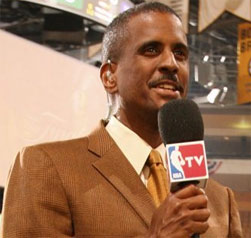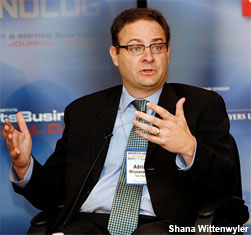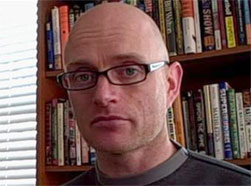Twitter is a major platform for journalists to break stories, share work and chat with fans. The most popular national NBA writers claim several hundred thousand followers, while local writers may attract as many as 40,000. The most-followed NBA writer in THE DAILY’s survey of Twitter accounts is ESPN's Chris Broussard, with more than 530,000 followers. The list below shows Twitter followers for many of the top national and local NBA writers, as well as for other NBA-related feeds. In addition, THE DAILY conducted an e-mail roundtable with three leading national NBA writers -- Yahoo Sports’ Adrian Wojnarowski, NBA.com’s David Aldridge and TrueHoop’s Henry Abbott -- on their Twitter use and how its explosion has changed sports media.
NOTE: The number of Twitter followers listed for each feed was current as of this morning.
| WRITER | SITE/PUBLICATION | TWITTER FOLLOWERS |
| Chris Broussard | ESPN | 532,734 |
| Adrian Wojnarowski | Yahoo Sports | 312,096 |
| Marc Stein | ESPN | 215,556 |
| David Aldridge | NBA.com | 193,916 |
| Marc Spears | Yahoo Sports | 117,523 |
| John Hollinger | ESPN | 116,669 |
| SLAM magazine | | 107,035 |
| HoopsHype | | 86,508 |
| Brian Windhorst | ESPN | 82,500 |
| Henry Abbott | TrueHoop (ESPN) | 62,544 |
| Chris Sheridan | SheridanHoops.com | 48,162 |
| Chris Mannix | SI | 44,794 |
| Ken Berger | CBSSports.com | 44,244 |
| Sam Amick | USA Today | 38,174 |
| Howard Beck | N.Y. Times | 37,558 |
| Frank Isola | N.Y. Daily News | 35,394 |
| Zach Lowe | Grantland | 34,727 |
| Ira Winderman | South Florida Sun-Sentinel | 31,488 |
| Tim Reynolds | AP | 29,783 |
| Dime magazine | | 28,174 |
| | | |
 |
Aldridge first viewed Twitter as an annoyance,
but gradually gained an appreciation for the site |
Q: When did you first get on Twitter, and when did you become serious about using it for the NBA beat?
Aldridge: I started in September of 2010, I think. At the time I viewed it as an annoyance, another baby bird to feed, because I didn't think anyone could say anything important in 140 words. It was soon pointed out to me that it was 140 characters, not words, which only lowered my opinion of the medium. Of course, now, I am tethered to it like Ed White to Gemini IV. (Kids! Ask your grandparents who Ed White was! Or Gemini IV, for that matter.) There was no particular "aha!" moment of revelation; just a gradual understanding that this is where the eyeballs were and you weren't serving your audience if you weren't here as well.
Wojnarowski: Prior to the 2009 NBA Draft, I was discussing with our editor, Johnny Ludden, about trying to find a way to get all the information I was gathering leading up to the draft -- and especially during the draft -- onto the website before it was obsolete. In many instances, I had the information on draft picks about to be chosen well before the names were announced on the podium in New York -- as well as trades, etc. While we had dumb looks on our faces, his fiancee, Jennifer Banda, looked up and said to us, "Put it on Twitter." Johnny and I said, "Oh. Good idea." And that's when I started @WojYahooNBA.
Abbott: When I first started TrueHoop, the comments were densel- packed smart talk. Or at least, that's how I remember them. Then the site got more popular, moved to ESPN, and before long a lot of the comments had more of a catty teenager vibe. So ... where did all those smartypants interesting people go to talk about the NBA? At some point a couple of years ago it became pretty clear the answer was Twitter. Once you know the cool kids are there, it ends up making sense to play that crowd. I remember an editor once telling me to step up my Twitter game, and I'm glad I did.
Q: How has Twitter changed the way you report stories? What are some upsides/downsides to using social media?
Abbott: My favorite stories are very thoughtful, and in being so spazzy (I follow something like 1,600 people), Twitter can be an enemy of lucidity. I make no attempt to know everything on Twitter, nor to be early to every topic. There's a kind of zen thing you have to learn -- like when you're fishing you have to accept you will be aware of far more fish than you can catch. However, I'd never want to go without it. When you want to know what people are thinking, 1,600 people are ready to fill you in around the clock.
Aldridge: You report first on Twitter now. I think everyone I work with understands that the immediacy of the medium makes it the best place to give folks the headline. You then get them to your website with the detailed story in the next few minutes, and flesh it out with more info as you get it. Of course, the demand and competition produce incredible pressure to be first. I still prefer being right over being first, which means you don't get credit for the "scoop" a lot of times while you're waiting for confirmation from additional sources. But that's life in the big city. I try not to respond to the yahoos with Twitter Muscles who say nasty things, but I do tell them -- and everyone else -- that they're getting blocked.
Wojnarowski: It hasn't changed the way I report stories. The process is precisely the same: Report relentlessly, get it right and try real hard to get it first. In most instances, I'll post breaking news on twitter before I file a story to Yahoo. If I don't do that, there's a good chance I'll get beat waiting for the story to get posted on the site. As soon as the story link is live on Yahoo, I'll post the link to Twitter. Ultimately, Twitter allows you to gain ownership of the story and its details. To me, the upside is that it's an immediate scoreboard. No longer can organizations take credit for stories that another has broken. Everyone sees everything and we're all accountable on a moment-to-moment basis; as we should be. Who gets it first is important. But I've always understood you can break 100 stories in a row, but people will remember the one you got wrong. So don't screw it up.
 |
Wojnarowski says he sees an increase in Twitter
followers when he breaks news |
Q: How closely do you monitor your follower numbers? When do you pick up the most followers?
Abbott: Not sure I have seen trends to their arrival ... other than after some multimillion-follower account like @ESPN or @NBA retweets something of mine.
Wojnarowski: It's always a good reminder to me of why people follow me on twitter -- they want breaking news. My follower numbers always spike when I've broken a big story, and around times of the year when the most breaking news is coming down -- the February trade deadline, the June draft and July free agency. Also, I found the NBA lockout to be a great opportunity to gain Twitter followers and drive traffic on stories, because I was able to break a lot of stories on the talks and people seemed to eager to get the information.
Aldridge: I'm not counting each one as they come aboard but I have a general sense they're going up. The lockout produced a major spike; people were hanging on every negotiation and every piece of info you could give them. During one of the long sessions that lasted 12-14 hours I had people writing in from six of the seven continents -- the only holdout was Antarctica. It was breakfast time in Europe and Africa, late afternoon in China and the middle of the night in New York where I was. Crazy. The draft, trade deadline and start of free agency on July 1 are also big times when I pick up followers.
Q: Who are your favorite Twitter follows around the NBA?
Aldridge: I love @FakeCoachPop. Brilliant. Obviously keep track of my Turner peeps, the competition and many of the players, but most of them don't say much other than what they had for breakfast.
Wojnarowski: For me, it's Marc Spears of Yahoo Sports. We work together to try and make Yahoo dominant on a day-to-day basis, and never care much which one of us is breaking a story -- as long as it's Yahoo Sports breaking the story, or telling a great tale. I'm not on twitter to be entertained, or goof around with people. It's an important part of our jobs, important to Yahoo's web presence and that's always my focus there.
Abbott: There are so many good ones. @johnhollinger @HoopIdea @KevinArnovitz @BeckleyMason @Byliner @Highway_30 @AminESPN @mindofAI9
Q: Are there times when you shut down Twitter?
Aldridge: I try to walk away, but it pulls me back in. I'll read but not respond while on vacation.
Abbott: If I'm parenting, writing, sleeping, eating, working out ... Many hours of the day Twitter simply has to manage without me. Which it's very good at.
Wojnarowski: I'm definitely off it, because my concentration isn't on what my competitors are writing or tweeting about, but working my own sources to stay ahead of the news, to know what's coming, to get it first and try and make others react to Yahoo!
 |
Abbott estimates that 95% of his tweets
are NBA related |
Q: Are there any other sports or non-sports subjects you like to tweet on, or do you confine yourself to the NBA?
Abbott: I'm 95% NBA, but man, one of my favorite Twitter moments ever was when the U.S. played England in the 2010 World Cup. Bed-ridden, fever-ravaged, obliterated by shortness of sleep, pneumonia and everything else, I was stranded on some hotel bed in Boston trying to find a doctor who would see me on a Saturday afternoon. In the middle of all that, the TV was on and America tied the game with, essentially, an England own-goal, off the hands of their keeper. The game finished 1-1. I tweeted one sentence about the English team being so polite, scoring one goal for each team. I'm sure it was more retweeted than anything I had tweeted before. The warm response lifted my spirits almost as much as the barrage of cold drugs and antibiotics I got from Mass General an hour or two later.
Wojnarowski: I have done so in the past, but very rarely. My belief is that less is more on twitter. People don't want me clogging their timelines with failed attempts at humor, or my political beliefs, etc. They come to me for the information on the NBA, and that's what I try to give them around the clock. It isn't about me; it's about the people and events that I cover. I try to remind myself of that every day.
Aldridge: I like talking with people about a lot of sports -- baseball, football, college basketball, hockey. I'm a sports fan. I really am interested in politics but no matter how much I write something down the middle, with no bent one way or the other, I get so much flak. I wrote that I thought [moderator] Martha Raddatz, not [Joe] Biden or [Paul] Ryan, did a good job in the vice presidential debate, and people on the right went crazy. Then I said I thought both Romney and Obama did a good job in the second debate, and people on the left called me out. You can't win.
Q: The NBA fanbase trends younger than other pro leagues. Do you see that difference in how you and your followers use Twitter? What differences do you see between NBA players/media Twitter usage and that in other sports?
Aldridge: For me, there is a recognition that most fans on Twitter are younger and you have to take that into account when you post things. There may not be that institutional memory there.
Wojnarowski: I do sense a lot of younger followers on Twitter. College kids, twentysomethings. And that's great, because it gives you hope that what you do will have an audience for years to come.
Abbott: I only cover the one sport, but seeing how thoroughly NBA players embrace the medium, I dare any other sport to try to catch up.






